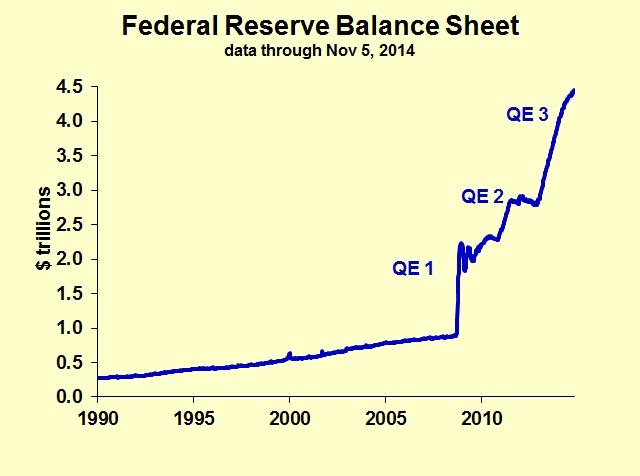I know it’s coming, but I’m not sure when. We will have a recession within the next few years, which is an easy forecast. Ten years is the longest we’ve gone between one recession and another, and we’re already five years past the end of the last one.
The Federal Reserve’s unwinding of its stimulus is the most likely cause of the next recession. For a while Europe was the most troubling threat. Although risk still comes to use from Europe and the Middle East, the Fed is now the greatest concern.
In the recession and recovery, the Fed injected a tremendous amount of stimulus through its three rounds of quantitative easing, shown on the chart as the three episodes of strong growth.
Quantitative easing may have been better than nothing, but it certainly did not create a booming economy. However, it does set the stage for a possible boom-bust cycle in the coming years.

Banks in the United States are holding on to $1.6 trillion in cash and deposits at the Federal Reserve. Back in 2007 they were happy holding less than $500 billion. That extra $1.1 billion sits idle, earning a measly 0.25 percent interest. Why don’t the banks put this money to work at a higher interest rate, by making loans to consumers and businesses? Because they don’t see enough applications from credit-worthy borrowers.
As I meet with bankers, though, I hear them say that they really would like to make more loans, and their credit standards are not tighter than historic norms. When I meet with small business owners and corporate CFOs, I hear them express caution. Consumers seem to be happy increasing their debt about in pace with their incomes, which is what they have been doing (aside from student loans).
As the economy improves, though, look for more borrowing. Businesses are feeling more optimistic and are likely to want to add capacity in the coming years. Consumers are more cheerful and may start to reach out for more loans. When demand from credit-worthy borrowers increases, the cash is ready to be lent out. Another trillion dollars of bank loans—in an $18 trillion economy—would get a boom going. As those loans are made and the borrowers start spending, more deposits will come into banks, enabling even more loans. In the jargon of economics it’s called multiple deposit expansion.













Leave A Comment